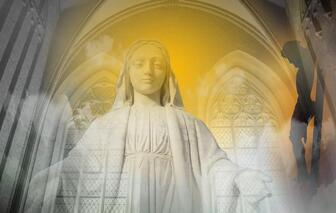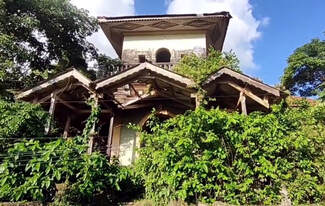 By M.P. Pellicer | Stranger Than Fiction Stories De Mello house sits abandoned somewhere on Goa, approximately 180 miles south of Bombay. The dark folklore surrounding the house stems from a dispute that supposedly led to murder between family members.  Mention of Dom George A. de Mello c.1864 (Source - The Morning Post) Mention of Dom George A. de Mello c.1864 (Source - The Morning Post) At the end of the 15th century Vasco Da Gama discovered the maritime route to Asia via the Cape of Good Hope. In a dozen years Portugal possessed Mangalore, Cochin, Ceylon, Ormuz, Diu, Goa and Negapatam. Europeans were spurred to find a route to the Orient, due to the Ottoman Empire blocking the route on the Silk Road to Asia via Turkey. They taxed anyone wanting to cross it exceptionally high amounts. The search for this sea route, also resulted in the discovery of the Americas by Western Europeans. 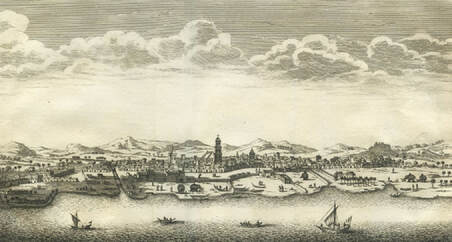 Vue de Goa by Jacques Nicolas Bellin depicting the Ribeira Grande and its adjoining dockyards c.1752 Vue de Goa by Jacques Nicolas Bellin depicting the Ribeira Grande and its adjoining dockyards c.1752 In 1510, the Portuguese conquered the ruling sultan and set up Velha Goa (Old Goa). Portugal ruled the settlement for the next four and a half centuries, and the enclave became known as Portuguese, India. After 1585, it was decided to establish shipyards so vessels could be made in Goa, using the teakwood available in the area. The shipyard went through several names — Ribeira, Ribeira das Armadas, Ribeira das Naus, Ribeira Grande and finally Arsenal da Marinha Exercito. It was this shipyard which allowed the Portuguese to dominate expansion in Asia, despite its shortage of manpower. There were fleets of ships funded by the Portuguese royal court that were dispatched yearly from Portugal to Goa. Known as the "India Run" (Carreira da India) it was the main carrier of the spice trade between Europe and Asia during the 16th century. The carrack Cinco Chagas and the galleons Bom Jesus and Madre de Deus used during the Dutch Portuguese wars were made at this shipyard. The ships would dock at Ribeira das Gales, but it wasn't only ships that were here, but there were living quarters for officials and a prison for convicts brought onboard the ships. There were several important buildings there such as: Casa da Moeda (Royal Mint), Artilharia (Gun Foundry), Casa de Pólvora (Gunpowder Factory), Alfandega (Customs-House, later moved to Panjim), the Bangaçal (where cargo was stored), the Peso (where cargo was weighed) and finally the elephant stables. "The private chapel of the Ribeira Grande was dedicated to the Cinco Chagas (Five Wounds) and in a corner of the Ribeira, on the eastern side was located the Church of Santos Mártires (Holy Martyrs)." In 1878, Jose Nicolau da Fonseca made the following observation on the state of the Ribeira Grande: There is nothing at present to show the once flourishing conditions of these places. Instead of the bustle that once prevailed here, a complete silence now reigns, broken only by the wind whistling through the branches of the palm-trees which grow luxuriantly on the spot. 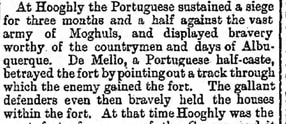 de Mello and the Hoogly siege (Source - Liverpool Mercury c.1891) de Mello and the Hoogly siege (Source - Liverpool Mercury c.1891) The De Mello family history stretches back into the 16th century, and was always well connected to the Portuguese court. In 1864, there was a mention made that Dom George A. de Mello was the aide-de-camp to the Governor General of Goa, and by 1870 he was Governor General of Portuguese, India himself. However there were other De Mello involved in the history of Goa. In 1632, the Mughal Army attacked the Portuguese garrison at Fort Hoogly. There is mention made that during the siege, which lasted over 3 months, a De Mello, "a Portuguese half-caste" betrayed the fort by providing a way for the enemy to enter the fort. 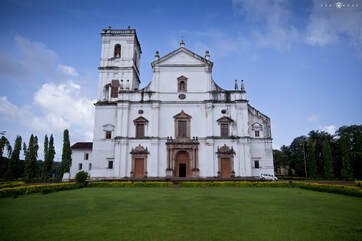 The 1619 Se Cathedral at Old Goa is an example of Portuguese architecture and is one of the largest churches in Asia The 1619 Se Cathedral at Old Goa is an example of Portuguese architecture and is one of the largest churches in Asia So it's not clear which part of the De Mello family spawned the dark stories concerning the derelict house in Goa. The urban myth describes where two brothers were given ownership over the same property, however it seemed bitter feelings developed. The situation ended tragically when one brother killed the other, and then the second brother died soon after, some say by his own hand. The house was then said to be haunted by the tormented souls of the brothers, and the family members which took possession of the property were visited by a curse. Maria de Lourdes Bravo da Costa Rodrigues a librarian and reporter wrote an article in 2015, concerning stories published about the De Mello House (D'Mello). She described being familiar with the D'Mello family and the story lacks substantiation. She says there is no De Mello house in Santemol, however there is one in Raia, which was left empty after the family moved away. As an abandoned property it was vandalized, but there was no history of fratricide. The ancient town of Old Goa (Velha Goa) sits at the mouth of the Mandovi River. In 1516, the population in Old Goa was about 200,000 when cholera of a virulent type broke out, and spread so fast over the city that persons of "every age, rank and sex were daily swept away in great numbers." Even poultry and livestock died. The bell tolled so much to signal the deaths, that Martim Affonso de Souza, the governor forbade the tolling of the bell for any funeral. In 1570, the city was attacked by Ali Adil Shah with an army of 100,000 men and 2,140 elephants. There were only 700 European soldiers, 300 friars and clergymen and the local populace. They were under siege for 10 months, but the attackers finally left after their numbers were reduced by sickness and fighting. Food became scarce and there was famine, followed by an epidemic fever of a "virulent character". It was determined that it wasn't only the attack, but the location of the city since it was surrounded by stagnant pools and marshes. There was no hygiene for public health, and the water supply of the city was very bad especially in the hot season. The streets were also not kept clean. At one point the body of a dead elephant was thrown into a lake near the Church of Trindade. In 1635 another epidemic fever broke out "spreading desolation and devastation all around." As the city suffered the scourge of the epidemic, in 1639 the Dutch blockaded Goa harbor with 12 ships. They subsequently left, perhaps fearing contagion. In 1687, the capital was moved away from Old Goa, leaving behind many baroque ruins, more than 100 churches, monasteries and royal courts designed in Renaissance architecture. The buildings were used as a quarry for the new capital, taking what many believed was its curse to the new city. In 1859, what was known as the Chorão Epidemic claimed 1,000 men, women and children in Chorão an island on the Mandovi River. Thousands fled the island, and it was deserted for almost 100 years. 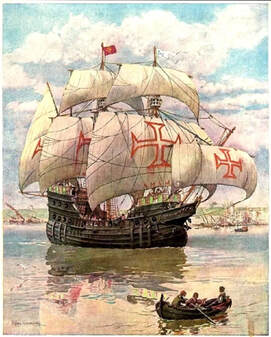 Portuguese Caravela Portuguese Caravela Even if the haunting of the De Mello House is more urban myth than reality, there is so much history in this ancient city that could account for strange occurrences. There are the thousands that died from plagues. In Margao the oldest city in Gao, there is a hill adjoining the town, which allows a view of the town and also of the sea and surrounding villages. It was crowned by a chapel dedicated to Nossa Senhora de Piedade (Our Lady of Mercy), which was regarded by the locals as their special patroness. The chapel was originally constructed by the Jesuits and dedicated to the Holy Cross, with the view as stated by their chronicler of "delivering the place from the annoyances of the evil spirits by which it was then haunted." The chapel was rebuilt in 1820. In 1565 a church dedicated to St. Paul was erected by the Jesuits on the ruins of a main pagoda, and the idol of Damodar was removed to Zambaulin. The church was burned by the Muslims and was rebuilt in 1585. It decayed and was reconstructed in 1645. One of its altars was dedicated to St Roch who interceded for the village, which was in the throes of an epidemic that lasted from 1772 to 1776. Under the chief altar there is said to be a slab of black stone covering the grave of a native child killed with Jesuits at Cuncolim. 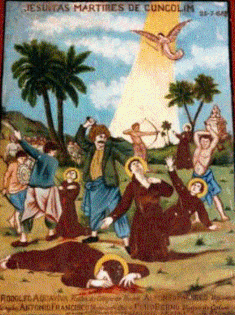 17th century painting in a church in Colva depicting the martyrdom of the five Jesuits in Cuncolim, Goa on July, 15, 1583. 17th century painting in a church in Colva depicting the martyrdom of the five Jesuits in Cuncolim, Goa on July, 15, 1583. The Cuncolim Massacre involved the mutilation of priests and civilians, by Hindu chieftains in the Goa village of Cuncolim on July 15, 1583. Five Jesuits, one Portuguese civilian and 14 Goan Catholics were killed. Besides the many that died through disease or misadventure, there are forgotten cemeteries, where perhaps the spirits do not lie quietly in their graves. There was the Fortress of Cabo built a few years after 1540 on the western end of Goa. By 1878, all that was left were ruins and three cisterns. At the beginning of the 18th century, the Portuguese allowed the British to erect a hospital, barracks and other buildings, which were demolished in 1848. The only thing left was a cemetery, with 38 tombs, only 6 bearing epitaphs. The Inquisition came to Goa in 1500, and the officials were housed in an existing, 3-story palace made of black stone. It was in the great square close to the cathedral, and known as the Palace of the Inquisition. It was initially staffed by three Dominicans, however by 1682 the number had increased to 32, and ultimately there would be a staff of 48. 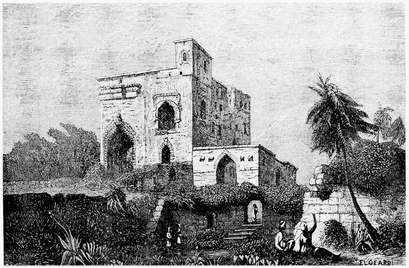 Ruins of the headquarters of the Goa Inquisition c.1905 Ruins of the headquarters of the Goa Inquisition c.1905 There was a chamber in the palace known as the Meza do Santo Officio, which was decorated with green taffeta curtains. There was a huge crucifix propped against the tapestry that almost touched the ceiling. According to stories told by the inhabitants of Goa, every individual charged with witchcraft, or any offense against the Catholic religion was "placed before this crucifix, when all of a sudden a thrill appeared to pass through the person's frame, they would tremble from head to foot and drop senseless on the ground, incapable of fixing their eyes on it anymore." On a raised dais were the Inquisitors and other officers. The palace had other rooms and a great number of prison cells. In 1774, the Inquisition was disbanded and restored in 1779, and abolished in 1812. The derelict building was pulled down in 1820. The religious orders were expulsed in 1835, and their properties were appropriated by the government. There are many places long forgotten that could make a shiver run up your spine, when a coolness in the air is the only sign that one who is no longer of this world walks with you.
0 Comments
Your comment will be posted after it is approved.
Leave a Reply. |
Stranger Than Fiction StoriesM.P. PellicerAuthor, Narrator and Producer Archives
July 2024
Categories
All
|
Stories of the Supernatural
- Stories of the Supernatural
- Miami Ghost Chronicles
- M.P. Pellicer | Author
- Stranger Than Fiction Stories
- Eerie News
- Supernatural Storytime
-
Astrology Today
- Tarot
- Horoscope
- Zodiac
-
Haunted Places
- Animal Hauntings
- Belleview Biltmore Hotel
- Bobby Mackey's Honky Tonk
- Brookdale Lodge
- Chacachacare Island
- Coral Castle
- Drayton Hall Plantation
- Jonathan Dickinson State Park
- Kreischer Mansion
- Miami Biltmore Hotel
- Miami Forgotten Properties
- Myrtles Plantation
- Pinewood Cemetery
- Rolling Hills Asylum
- St. Ann's Retreat
- Stranahan Cromartie House
- The Devil Tree
- Trans-Allegheny Lunatic Asylum
- West Virginia Penitentiary
- Paranormal Podcasts
"When misguided public opinion honors what is despicable and despises what is honorable, punishes virtue and rewards vice, encourages what is harmful and discourages what is useful, applauds falsehood and smothers truth under indifference or insult, a nation turns its back on progress and can be restored only by the terrible lessons of catastrophe."
- Frederic Bastiat
- Frederic Bastiat

Copyright © 2009-2024 Eleventh Hour LLC. All Rights Reserved ®
DISCLAIMER
DISCLAIMER
 RSS Feed
RSS Feed













